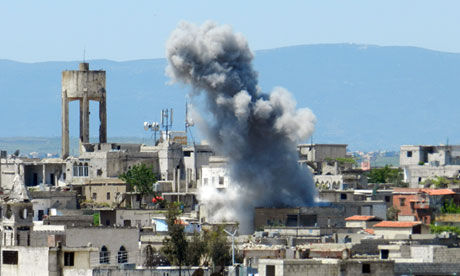
New questions have emerged over the source of the soil and other samples from Syria which, it is claimed, have tested positive for the nerve agent sarin, amid apparent inconsistencies between eyewitness accounts describing one of the attacks and textbook descriptions of the weapon.
As questions from arms control experts grow over evidence that the Assad regime has used chemical weapons on a limited scale on several occasions, one incident in particular has come under scrutiny.
While the French, UK and US governments have tried to avoid saying where the positive sarin samples came from, comments by officials have narrowed down the locations to Aleppo and Homs.
Last week the Obama administration suggested that Syrian government forces may have used the lethal nerve gas in two attacks. Opposition fighters have accused regime forces of firing chemical agents on at least four occasions since December, killing 31 people in the worst of the attacks.
A letter from the British government to the UN demanding an investigation said that it had seen "limited but persuasive evidence" of chemical attacks, citing incidents on 19 and 23 March in Aleppo and Damascus and an attack in Homs in December, suggesting strongly that samples were taken at these locations.
A US defence official, who spoke on condition of anonymity to the Los Angeles Times, appeared to confirm that one of the samples studied by the US was collected in December - suggesting that it too originated in Homs.
According the US Centres for Disease Control and Prevention, "sarin is a nerve agent that is one of the most toxic of the known chemical warfare agents. It is a clear colourless liquid ... generally odourless and tasteless".
But eyewitness accounts of that attack, in which six rebels died and which were reported at the time by the Associated Press described "white smoke" pouring from shells that "smell[ed] ... like hydrochloric acid".
The suggestion that one of the sarin-positive samples may have originated in Homs has added to the growing confusion surrounding the claims made with different degrees of caution by the Israeli, French, UK and US governments in recent days.
According to the US and UK governments, "miniscule" samples recovered by opposition sources and passed on to western intelligence agencies have shown traces of sarin. No other agents have been mentioned.
While the contradictions between the eyewitness accounts and traces of sarin in the samples may well be attributable to the confusion of battle, it underlines the uncertainties around the claims, which have included questions about whether some of the videotaped symptoms are consistent with sarin exposure.
Reflecting just how little is known about the circumstances in which people may have been exposed to chemical agents in Syria, President Barack Obama has said: "Knowing that potentially chemical weapons have been used inside of Syria doesn't tell us when they were used, how they were used. We have to act prudently. We have to make these assessments deliberately." Obama warned in December that the Assad regime would face "consequences" if it were disclosed that chemical weapons had been used.



Reader Comments
to our Newsletter